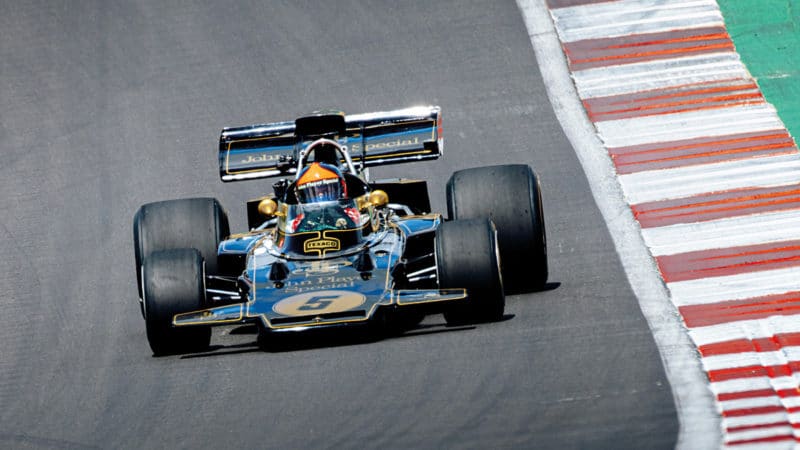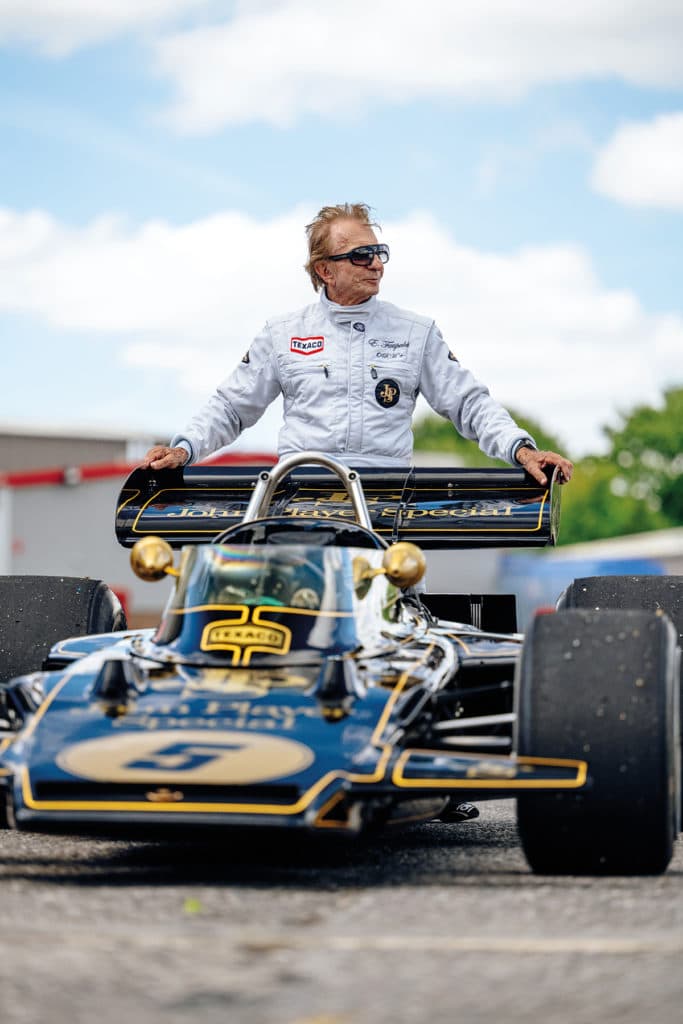Back in black: Lotus and Emerson reunited at Brands Hatch
When you get the chance to reunite a world champion with one of the sport’s most iconic cars, there are few places better than Brands Hatch. Simon Arron went to witness it

Jayson fong
It’s one of motor racing’s most familiar photographic clichés: black livery with gold flourishes, distinctive dark helmet with elegant red swirls, driver’s head cocked to one side as he coaxes his car towards the Druids apex. Lotus 72, Emerson Fittipaldi, Brands Hatch.
It’s hard to imagine nowadays, but 50 years ago that title-winning combination appeared four times in the course of a single season at the Kent circuit. Today Fittipaldi is back at Brands Hatch to be reunited with Lotus 72/7, the chassis he used through most of that successful 1972 campaign. He is here with Sky Sports to produce a mini-documentary marking the 50th anniversary of his first world title, which back then made him the sport’s youngest champion, at 25.
His presence – and that of Damon Hill, on TV duty – comes as a surprise to those who’d brought along their Renault Clios and Honda Civics, thinking this was just an ordinary track day and without the slightest clue about who or what might make an appearance on the circuit during the lunch break.
“I love this place,” Fittipaldi says. “I raced here in Formula Ford and F3 before F1 and it always felt very special – big crowds, elevation changes, fast corners, mid-speed corners, uphill corners, downhill corners… It’s very technical and you needed both driver and car to be working properly. Fortunately, the Lotus 72 was good at every kind of circuit.”

Sky Sports’ film marking the 50th anniversary of Fittipaldi’s world championship will be broadcast over the weekend of the Italian GP
To recap, in 1972 Fittipaldi appeared at Brands Hatch in the Race of Champions (March 19, won from pole), British Grand Prix (July 15, won from second on the grid), Rothmans 50,000 (August 28, an anything-goes big-money Formula Libre race, which he won from pole) and the World Championship Victory Race (October 22, when he qualified on pole but retired with failing oil pressure). In addition, he won Silverstone’s International Trophy on April 23 and five weeks later finished second to Denny Hulme at Oulton Park, the last time the Cheshire circuit hosted a race for contemporary F1 cars. He also raced a 72 at Brands in two non-championship races in 1971 (one second place, one retirement) and the 1973 Race of Champions, when he was sidelined early by a broken fuel metering unit.
“I love this place. I raced here in Formula Ford and F3 before F1”
“Brands definitely holds a special place in my heart,” he says. “When I left Brazil to race in the UK in 1969 my dream was to start a grand prix. Even if it was only one, that would have been enough – I could have died the following day and still been happy. I certainly wasn’t thinking about becoming world champion, or anything like that.”
From arriving to compete in Formula Ford, it took only 18 months for the Brazilian to make his F1 debut, at the wheel of one of Lotus’s by-then-outdated 49s in the British GP at Brands Hatch. “I lined up alongside Graham Hill in Rob Walker’s Lotus,” he says, “and told myself, ‘This is your dream.’ At home in Brazil, guys like Graham Hill, Jack Brabham, Jackie Stewart, Denny Hulme, Chris Amon and Jacky Ickx were heroes for me, absolute monsters, but here I was racing against them.”
He finished eighth that day, fourth next time out in Germany, 15th in Austria and was scheduled to make his first start in a 72 at Monza. He damaged the car in a practice accident, however, and Lotus withdrew from the meeting soon afterwards in the wake of Jochen Rindt’s fatal accident. His first start in a 72, then, would be at Watkins Glen, his fifth world championship race and his first as Lotus’s rookie team leader. He started third and went on to win by more than half a minute, the first of his 14 such victories.
“Everybody talks about me being the ‘first’ Brazilian,” he says, “but really that was Chico Landi, who contested some world championship grands prix in the 1950s – he was a good friend of my father Wilson, who came over with him to provide commentaries for Brazilian radio. The very first time I met Enzo Ferrari, he started by asking me how Chico was doing!”
It is time for Fittipaldi, now 75, to get himself suited and booted. Hill also has a run in the 72 – the family’s London Rowing Club helmet colours complement the JPS livery, but look a little odd as his dad raced a 72 clothed only in Rob Walker Racing blue – but plans to give Fittipaldi’s son Emerson Jr a run have to be abandoned. The 15-year-old is competing this year in the Italian F4 Championship, but it wouldn’t have been possible to adjust the Lotus to his shorter frame in the time available.
The format is simple. A slow lap behind the camera car, off the leash for a couple of minutes, then another filming lap and repeat. Fittipaldi has been smiling ever since he arrived, but the trademark grin is perceptibly broader once his stint comes to an end.
“Given all my history here, with Colin Chapman and the 72, I’m very blessed to be back at Brands,” he says, sipping from yet another cup of tea, something he has been chain-drinking to counteract the ravages of a sore throat. “It was lovely to see Damon out in it, too. I know I have demonstrated 72s many times, but to drive one again here… Paddock Hill Bend, Druids… all the memories came flooding back – and the car even still smells the same. It felt perfect, too – Chris Dinnage [a former Lotus employee, who was Ayrton Senna’s chief mechanic and is nowadays team manager at Classic Team Lotus] and the guys have done an amazing job.”
Does he have a favourite Brands Hatch memory, with or without the Lotus 72?
“It would have to be the British Grand Prix here in 1972,” he says, “because I was trying to establish myself in the world championship battle and it was a very tough race against Jacky Ickx’s Ferrari and Jackie Stewart’s Tyrrell. There was a lot of pressure, a lot of adrenaline, but the car was absolutely spot on. Colin Chapman was a design genius, but he was also brilliant in terms of chassis set-up and understanding how to get the best from the car during a race.
“There wasn’t a single particular moment that stands out from that afternoon, it was just the day as a whole – and it was special to win for Colin on home soil, just as Jim Clark and Jochen Rindt had done in previous years.”
And had his father been there for a Brazilian radio station?
“Yes,” he says. “He commentated on all of my F1 races and always managed to keep his emotions in check, even when I was winning. I think the only exception to that was Monza in 1972, when I clinched my first world title. For once, he was unable to stop himself jumping around.”

